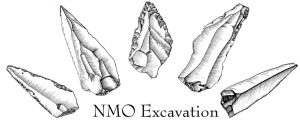Probably the most significant characteristic of the NMO assemblage is its small size. After eight seasons of excavation at the almost 50 square meters of Area D, we have fewer than 1000 flint artifacts (>2 cm.) excavated in situ. This is an extremely low density, incomparable to any other MP site in the Levant.
The other unique characteristic of the assemblage is its typological composition. The percentage of tools within the assemblage is very high, currently about 30% The assemblage is dominated by two groups of artifacts defined as cutting tools and pointed elements, many of them made of high-quality flint. Moreover, the NMO assemblage is unique among other MP assemblages not only for its frequency of cutting tools and pointed elements, but also in the absence of other tool types typically present in significant numbers in such assemblages. There are very few scrapers in the assemblage, and the same is true for other tool types such as burins, awls, end scrapers, and many others such as notches and denticulate
This unique typological composition resulted from the functional selectivity of the site inhabitants. The primary task that took place at the site was the butchering of large, hunted game. Pointed elements and cutting tools, the tools dominating the assemblage, were brought into the site for this purpose.
The taxonomic classification of the humans occupying NMO is unknown. It has been widely accepted that Neanderthals were the dominant species during the final MP in the Levant, but recent data from the Manot Cave suggest the coexistence of anatomically modern humans in the Levant. The debate over the presence of Neanderthals in the Levant is far beyond the scope of this paper. In the context of the question of Neanderthal replacement by modern humans, analysis shows that the material culture of the NMO people is situated well within MP boundaries. Yet, its features are modern, if you like, representing a significant advance.
